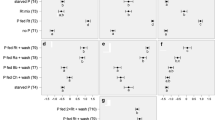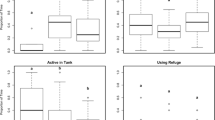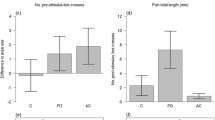Abstract
Predators have been widely demonstrated to influence developmental plasticity in aquatic prey. We investigated the body size of the amphipod Hyalella azteca raised with predatory sunfish by exposing solitary or groups of three amphipods to sunfish kairomones or a control for 30 days. Field studies indicate that small body size in H. azteca is likely an adaptive response to size-selective sunfish predation. Grouped amphipods chronically exposed to the kairomones had significantly smaller body lengths than grouped amphipods exposed to controls, while individual amphipods exhibited no significant differences. Behavioral trials revealed that grouped amphipods sought refuge less than solitary amphipods. To examine if a conspecific chemical cue was related to the reduction in body size of the grouped amphipods exposed to kairomones, individual amphipods were exposed to a combination of conspecific chemical cues and kairomones or to controls for 30 days. Amphipods exposed to kairomones in combination with conspecific cues had significantly smaller body length than amphipods exposed to conspecific cues alone. These results mirrored the group versus individual exposure experiment, suggesting that a conspecific chemical cue is required to induce an anti-predator response. The present study highlights the importance of conspecific cues for plastic responses to predators.


Amphipod image credit: Dieter Tracey, IAN Image Library (www.ian.umces.edu/imagelibrary/)

Similar content being viewed by others
References
Anstey, M. L., S. M. Rogers, S. R. Ott, M. Burrows & S. J. Simpson, 2009. Serotonin mediates behavioral gregarization underlying swarm formation in desert locusts. Science 323: 627–630.
Bousfield, E., 1958. Fresh-water amphipod crustaceans of glaciated North America. Canadian Field-Naturalist 72: 55–113.
Brown, G. E., T. Bongiorno, D. M. Dicapua, L. I. Ivan & E. Roh, 2006. Effects of group size on the threat-sensitive response to varying concentrations of chemical alarm cues by juvenile convict cichlids. Canadian Journal of Zoology 84: 1–8.
Brown, G. E., M. C. O. Ferrari, P. H. Malka, M. A. Oligny, M. Romano & D. P. Chivers, 2011. Growth rate and retention of learned predator cues by juvenile rainbow trout: faster-growing fish forget sooner. Behavioral Ecology and Sociobiology 65: 1267–1276.
Brown, G. E., M. C. O. Ferrari, C. K. Elvidge, I. Ramnarine & D. P. Chivers, 2013. Phenotypically plastic neophobia: a response to variable predation risk. Proceedings of the Royal Society B: Biological Sciences 280: 20122712.
Brown, G. E., D. P. Chivers, C. K. Elvidge, C. D. Jackson & M. C. O. Ferrari, 2014. Background level of risk determines the intensity of predator neophobia in juvenile convict cichlids. Behavioral Ecology and Sociobiology 68: 127–133.
Chivers, D. P. & R. J. F. Smith, 1998. Chemical alarm signalling in aquatic predator–prey systems: a review and prospectus. Ecoscience 5: 338–352.
Chivers, D. P., X. Zhao, G. E. Brown, T. A. Marchant & M. C. O. Ferrari, 2008. Predator-induced changes in morphology of a prey fish: the effects of food level and temporal frequency of predation risk. Evolutionary Ecology 22: 561–574.
Crispo, E., 2008. Modifying effects of phenotypic plasticity on interactions among natural selection, adaptation and gene flow. Journal of Evolutionary Biology 21: 1460–1469.
Dingle, H., 2014. Migration: The Biology of Life on the Move. Oxford University Press, New York.
Dodson, S. I., 1974. Adaptive change in plankton morphology in response to size-selective predation: a new hypothesis of cyclomorphosis. Limnology and Oceanography 19: 721–729.
Domenici, P. & R. Batty, 1997. Escape behaviour of solitary herring (Clupea harengus) and comparisons with schooling individuals. Marine Biology 128: 29–38.
Ferrari, M. C. O., B. D. Wisenden & D. P. Chivers, 2010. Chemical ecology of predator–prey interactions in aquatic ecosystems: a review and prospectus. Canadian Journal of Zoology 88: 698–724.
Frommen, J. G., F. Herder, L. Engqvist, M. Mehlis, T. C. M. Bakker, J. Schwarzer & T. Thünken, 2011. Costly plastic morphological responses to predator specific odour cues in three-spined sticklebacks (Gasterosteus aculeatus). Evolutionary Ecology 25: 641–656.
Ghalambor, C. K., J. K. McKay, S. P. Carroll & D. N. Reznick, 2007. Adaptive versus non-adaptive phenotypic plasticity and the potential for contemporary adaptation in new environments. Functional Ecology 21: 394–407.
Ghalambor, C. K., K. L. Hoke, E. W. Ruell, E. K. Fischer, D. N. Reznick & K. A. Hughes, 2015. Non-adaptive plasticity potentiates rapid adaptive evolution of gene expression in nature. Nature 525: 372–375.
Gilliam, J. F. & D. F. Fraser, 1987. Habitat selection under predation hazard: test of a model with foraging minnows. Ecology 68: 1856–1862.
Gliwicz, M. Z., 1986. Predation and the evolution of vertical migration in zooplankton. Nature 320: 746–748.
Gosline, A. K. & F. H. Rodd, 2008. Predator-induced plasticity in guppy (Poecilia reticulata) life history traits. Aquatic Ecology 42: 693–699.
Gutiérrez, M. F., J. C. Paggi & A. M. Gagneten, 2010. Fish kairomones alter life cycle and growth of a calanoid copepod. Journal of Plankton Research 32: 47–55.
Handelsman, C. A., E. W. Ruell, J. Torres-Dowdall & C. K. Ghalambor, 2014. Phenotypic plasticity changes correlations of traits following experimental introductions of Trinidadian guppies (Poecilia reticulata). Integrative and Comparative Biology 54: 794–804.
Hazlett, B., 1985. Disturbance pheromones in the crayfish Orconectes virilis. Journal of Chemical Ecology 11: 1695–1711.
Hazlett, B., 2011. Chemical cues and reducing the risk of predation. In Breithaupt, T. & M. Thiel (eds), Chemical Communication in Crustaceans. Springer, New York: 355–370.
Hettyey, A., Z. Tótha, K. E. Thonhauser, J. G. Frommen, D. J. Penna & J. Van Buskirk, 2015. The relative importance of prey-borne and predator-borne chemical cues for inducible antipredator responses in tadpoles. Oecologia 197: 699–710.
Heuschele, J. & E. Selander, 2014. The chemical ecology of copepods. Journal of Plankton Research 36: 895–913.
Hirsch, P. E., D. Cayon & R. Svanbäck, 2014. Plastic responses of a sessile prey to multiple predators: a field and experimental study. PLoS ONE 9: e115192.
Hoverman, J. T. & R. A. Relyea, 2007. How flexible is phenotypic plasticity? Developmental windows for trait induction and reversal. Ecology 88: 693–705.
Huang, Y. M., M. O. Amsler, J. B. McClintock, C. D. Amsler & B. J. Baker, 2007. Patterns of gammaridean amphipod abundance and species composition associated with dominant subtidal macroalgae from the western Antarctic Peninsula. Polar Biology 30: 1417–1430.
Johnson, J. B. & M. C. Belk, 2001. Predation environment predicts divergent life-history phenotypes among populations of the livebearing fish Brachyrhaphis rhabdophora. Oecologia 126: 142–149.
Jordão, L., 2004. Disturbance chemical cues determine changes in spatial occupation by the convict cichlid Archocentrus nigrofasciatus. Behavioural Processes 67: 453–459.
Kullmann, H., T. Thünken, S. A. Baldauf, T. C. Bakker & J. G. Frommen, 2008. Fish odour triggers conspecific attraction behaviour in an aquatic invertebrate. Biology Letters 4: 458–460.
Lass, S. & P. Spaak, 2003. Chemically induced anti-predator defences in plankton: a review. Hydrobiologia 491: 221–239.
Lawrence, S. G., 1981. Manual for the Culture of Selected Freshwater Invertebrates, Department of Fisheries and Oceans.
Maher, J. M., E. E. Werner & R. J. Denver, 2013. Stress hormones mediate predator-induced phenotypic plasticity in amphibian tadpoles. Proceedings of the Royal Society B: Biological Sciences 280: 20123075.
McCoy, M. W., 2007. Conspecific density determines the magnitude and character of predator-induced phenotype. Oecologia 153: 871–878.
Meuthen, D., S. A. Baldauf, T. C. M. Bakker & T. Thünken, 2015. Predator-induced neophobia in juvenile cichlids. Oecologia 181: 947–958.
Michimae, H. & J. I. Hangui, 2008. A trade-off between prey- and predator-induced polyphenisms in larvae of the salamander Hynobius retardatus. Behavioral Ecology and Sociobiology 62: 699–704.
Moczek, A. P., S. Sultan, S. Foster, C. Ledón-Rettig, I. Dworkin, H. F. Nijhout, E. Abouheif & D. W. Pfennig, 2011. The role of developmental plasticity in evolutionary innovation. Proceedings of the Royal Society B: Biological Sciences 278: 2705–2713.
Nishizaki, M. T. & J. D. Ackerman, 2005. A secondary chemical cue facilitates juvenile–adult postsettlement associations in Red Sea urchins. Limnology and Oceanography 50: 354–362.
Pearl, C. A., M. J. Adams, G. S. Schuytema & A. V. Nebeker, 2003. Behavioral responses of anuran larvae to chemical cues of native and introduced predators in the Pacific Northwestern United States. Journal of Herpetology 37: 572–576.
Pettersson, L. B. & C. Brönmark, 1997. Density-dependent costs of an inducible morphological defense in crucian carp. Ecology 78: 1805–1815.
Pfennig, D. W., 1990. The adaptive significance of an environmentally-cued developmental switch in an anuran tadpole. Oecologia 85: 101–107.
Pfennig, D. W., M. A. Wund, E. C. Snell-Rood, T. Cruickshank, C. D. Schlichting & A. P. Moczek, 2010. Phenotypic plasticity’s impacts on diversification and speciation. Trends in Ecology and Evolution 25: 459–467.
Pickard, D. P. & A. C. Benke, 1996. Production dynamics of Hyalella azteca (Amphipoda) among different habitats in a small wetland in the southeastern USA. Journal of the North American Benthological Society 15: 537–550.
Prezant, R. S., E. J. Chapman & A. McDougall, 2006. In utero predator-induced responses in the viviparid snail Bellamya chinensis. Canadian Journal of Zoology 84: 600–608.
Relyea, R. A., 2001. Morphological and behavioral plasticity of larval anurans in response to different predators. Ecology 82: 523–540.
Relyea, R. A., 2002. Competitor-induced plasticity in tadpoles: consequences, cues, and connections to predator-induced plasticity. Ecological Monographs 72: 523–540.
Simpson, S., E. Despland, B. Hägele & T. Dodgson, 2001. Gregarious behavior in desert locusts is evoked by touching their back legs. Proceedings of the National Academy of Sciences of USA 98: 3895–3897.
Stabell, O. B., F. Ogbebo & R. Primicerio, 2003. Inducible defences in Daphnia depend on latent alarm signals from conspecific prey activated in predators. Chemical Senses 28: 141–153.
Stamper, C. E., D. J. Stevens, J. R. Downie & P. Monaghan, 2008. The effects of competition on pre- and post-metamorphic phenotypes in the common frog. The Herpetological Journal 18: 187–195.
Stoks, R., M. De Block, F. Van de Meutter & F. Johansson, 2005. Predation cost of rapid growth: behavioural coupling and physiological decoupling. Journal of Animal Ecology 74: 708–715.
Teplitsky, C. & A. Laurila, 2007. Flexible defense strategies: competition modifies investment in behavioral vs. morphological defenses. Ecology 88: 1641–1646.
Thibert-Plante, X. & A. P. Hendry, 2011. The consequences of phenotypic plasticity for ecological speciation. Journal of Evolutionary Biology 24: 326–342.
Tollrian, R., 1990. Predator-induced helmet formation in Daphnia cucullata (Sars). Archiv für Hydrobiologie 119: 191–196.
Tollrian, R., S. Duggen, L. C. Weiss, C. Laforsch & M. Kopp, 2015. Density-dependent adjustment of inducible defenses. Scientific Reports 5: 12736.
Tonn, W. M., I. J. Holopainen & C. A. Paszkowski, 1994. Density-dependent effects and the regulation of crucian carp populations in single-species ponds. Ecology 75: 824–834.
Urban, M. C., 2008. The evolution of prey body size reaction norms in diverse communities. Journal of Animal Ecology 77: 346–355.
Walsh, M. R., F. Cooley, K. Biles & S. B. Munch, 2015. Predator-induced phenotypic plasticity within- and across-generations: a challenge for theory? Proceedings of the Royal Society B: Biological Sciences 282: 20142205.
Wellborn, G. A., 1994. Size-biased predation and prey life histories: a comparative study of freshwater amphipod populations. Ecology 75: 2104–2117.
Wellborn, G. A., 1995. Determinants of reproductive success in freshwater amphipod species that experience different mortality regimes. Animal Behaviour 50: 353–363.
Wellborn, G. A., 2002. Trade-off between competitive ability and antipredator adaptation in a freshwater amphipod species complex. Ecology 83: 129–136.
Wellborn, G. A. & R. D. Cothran, 2004. Phenotypic similarity and differentiation among sympatric cryptic species in a freshwater amphipod species complex. Freshwater Biology 49: 1–13.
West-Eberhard, M. J., 2003. Developmental Plasticity and Evolution. Oxford University Press, New York.
Wiackowski, K. & A. Staronska, 1999. The effect of predator and prey density on the induced defence of a ciliate. Functional Ecology 13: 59–65.
Williams, D. D. & K. A. Moore, 1985. The role of semiochemicals in benthic community relationships of the lotic amphipod Gammarus pseudolimnaeus: a laboratory analysis. Oikos 44: 280–286.
Wisenden, B. D., 2015. Chemical cues that indicate risk of predation. In Sorensen, C. & B. D. Wisenden (eds), Fish Pheromones and Related Cues. Wiley Blackwell, Oxford: 131–148.
Zamzow, J. P., C. D. Amsler, J. B. McClintock & B. J. Baker, 2010. Habitat choice and predator avoidance by Antarctic amphipods: the roles of algal chemistry and morphology. Marine Ecology Progress Series 400: 155–163.
Acknowledgements
We thank Julie Schram and CJ Brothers for assistance with fish collections. This research was supported by a Grant-In-Aid of Research from Sigma Xi and the Society of Integrative and Comparative Biology and the Department of Biology at the University of Alabama at Birmingham. J. B. M. also acknowledges support from a UAB Endowed University Professorship in Polar and Marine Biology. This study was performed in accordance with the University of Alabama at Birmingham Institutional Animal Care and Use Committee (Protocol #20041).
Author information
Authors and Affiliations
Corresponding author
Additional information
Handling editor: Lee B. Kats
Rights and permissions
About this article
Cite this article
James, W.R., McClintock, J.B. Anti-predator responses of amphipods are more effective in the presence of conspecific chemical cues. Hydrobiologia 797, 277–288 (2017). https://doi.org/10.1007/s10750-017-3191-6
Received:
Revised:
Accepted:
Published:
Issue Date:
DOI: https://doi.org/10.1007/s10750-017-3191-6




